Media | Articles
This reborn 1972 Indy car was salvaged from Parnelli Jones’ dumpster
When this winged beast hit the track for its first test session in February of 1972, the atmosphere in the Vel’s Parnelli Jones Racing (VPJ) garage must have been tense. As of that fall, the team had no car. Suddenly, it was tasked with sorting out what would become a trio of single-seaters sporting radical aero packages—with only four months to go before it loaded the trucks for the first race of the season in Trenton, New Jersey.
Perhaps the compressed timeline had spurred legendary designer Maurice Phillippe to unusual creativity. (He hadn’t officially begun designing for the Parnelli team until September, due to objections from previous employer Colin Chapman). From a distance, if you squinted, the VPJ-1 cut a similar profile to the Lola-based Colts campaigned by Parnelli Jones Racing in 1971: wedge shape, squared-off nose, and a mid-mounted engine (in the Colt’s case, a turbocharged Ford V-8).
Most striking was VPJ-1’s dual set of wings integrated into its design, ahead of the high-flying, bolt-on affair behind the rear wheels. Up front were the first pair of upswept canards (just aft of the nose cone), followed by two dihedral wings that looked like they belonged on a plane, rather than a race car, jutting out at an angle of roughly 45 degrees behind the driver’s head. A giant NACA duct was carved into each sidepod, topped with a shoebox-sized rectangular duct, and fed cool air to an Offenhauser turbo-four. The rear brake discs sat inboard, paired with rising-rate rear suspension. Though the front brakes were mounted outboard, the front suspension setup was also rising rate. “Play it safe” was evidently not in Phillippe’s design brief, tight deadlines or not.
Fast-forward to November; Joe Leonard was crowned IndyCar champion of the ’72 season, despite a third at Indy that March. An evolution of Phillippe’s innovative design had carried the team to its third (and last) consecutive IndyCar championship. From Phoenix to Pocono to Ontario, the Parnelli Jones team had studied and tweaked the VPJ-1, refining what worked and excising what didn’t. As of early May, the dihedral wings were long gone—the experiment hadn’t improved the cars’ performance, and they were unceremoniously yanked mid-way through May during testing at Indianapolis.
The loss of the wings wasn’t the only change, either. Today’s VPJ-1 aficionados mark three distinct configurations of the car within the ’72 season: Mark 1, Mark 2, and Mark 3. Notable changes from Mark 1 test/early season car to Mark 3 season-ending setup included the replacement of the rising rate rear suspension with a more traditional system, similar to that of Gurney’s Eagle, and the relocation of the brake discs outboard.
Marketplace
Buy and sell classics with confidence
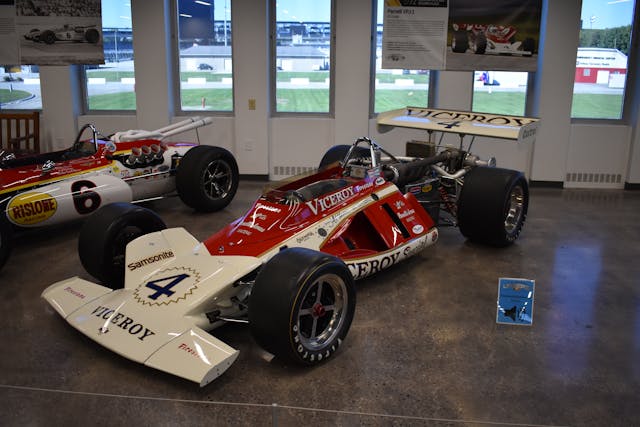
The same commitment to winning that birthed the VPJ-1—rendering it season champion after that—left one chassis, #102, abandoned in a dumpster. In late fall of 1972, during a Firestone tire test at Phoenix International Raceway, #102 suffered a right front suspension failure, sending it and Joe Leonard wall-surfing. The crash left the right side of the car badly mangled. The Parnelli Jones team, like any highly motivated race outfit already channeling its brainpower and wrenches to next season, didn’t waste time mourning the car’s loss.
All hope wasn’t lost for chassis #102, though. Fate was preparing a custodian for the abandoned VPJ-1. An Indiana farm kid with a passion for race cars, Chuck Jones was born into a family of engineers, though he acknowledges that his parents weren’t racing fanatics themselves: “Far from it, actually.” They did, however, like spending time with friends, and Chuck’s father’s best friend was an ex-B-24 pilot who frequented the sprint car races at Terre Haute, Indiana, and always had tickets to the 500.
“I saw my first Indy 500 when I was six months old—born in December, watching the race in May,” Chuck recalls. By six years old, Chuck found himself trackside at Terre Haute—and hooked for life. Two years later, he was dragging home a fire-ravaged go-kart bought with money he had earned from mowing lawns. When he wasn’t at Terre Haute watching A.J. Foyt, Mario Andretti, and Johnny Rutherford go wheel-to-wheel, he was putting his farm-bred fabrication skills to work rebuilding the ravaged kart.
He didn’t just have a knack for wrenching. By the time he was 15, Chuck was racing midgets professionally—first three-quarter, then full, followed by sprint cars. He was still racing five years later as a double-major working his way through Purdue with three jobs. Something had to give, and so Chuck put aside the helmet and gloves to finish school. Despite the decision not to go pro, he was never far from a track, and as he went to graduate school and built a career designing surgical robots, he stumbled upon vintage racing. He got hooked once again, not only by the driving experience, but by the opportunity to preserve and share history.
“Well and truly, it is my only hobby, outside of work,” he says. “Some people sail, some people play tennis—I find derelict Indy cars and give them a second life.”
When Chuck discovered VPJ-1 chassis #102, it was hanging from the rafters of a 30-foot-tall warehouse. Sometime in the ’80s, a nostalgic mechanic had fished the battered tub out of a dumpster in the dead of night and hid it in a corner of a garage.
“It’s amazing it didn’t end up in the landfill,” Chuck says, with no bitterness in his voice. “Racers are not sentimental people. They just want to get to the next race and be fast and win races.”
The car bounced around to any number of places—”Race teams go through their spring cleaning frenzies, just like the rest of us,” Chuck laughs—before he stumbled upon it in 2012.
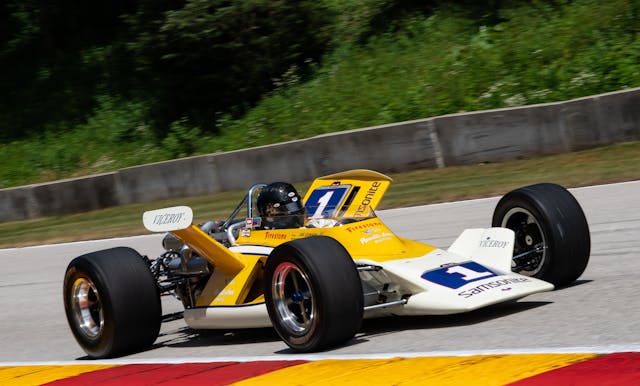
Chuck’s restoration of chassis #102 to track-ready Mark 1 spec is the product of the same human perseverance—mixed with nostalgia and sheer luck—that birthed this car and dug it out of a wastebin. He had found his next project, but it was a doozy. The VPJ-1 was only about 70 percent complete. The right-side suspension was gone, though the battered left assembly was in the pile of parts, along with the remains of the rear wing. In period, the team had begun to reskin the right side of the tub, damaged in the tire-test incident at Phoenix, but had soon realized that there wasn’t time to repair the car before the final race of the ’72 season. There was no engine or gearbox.
Chuck’s first task was inventory. Armed with a set of VPJ-1 parts drawings, a Sharpie, and “about a million Tupperware containers,” as he told HRT in 2017, Chuck spent four months figuring out what he did and didn’t have. Only then did he begin to source parts and begin any type of reassembly. With the help of John Capels (Leonard’s 1972 crew chief) and noted Indy car fabricator Alec Greaves, he used the left front suspension, which was mostly intact, to pattern a new assembly for the right side.
He tracked down and bought a period-correct, 36-degree Offenhauser four-cylinder from Al Unser, Sr. The engine, originally a R&D unit built by Dick Jones of Champion spark plugs, was then paired with the appropriate gearbox, a four-speed Hewland LG Mk II. The AirResearch turbocharger topping the 158-cubic-inch, DOHC mill received a complete rebuild: Chuck had all rotating components Magnafluxed and replaced all the bearings and seals. Total output, as in period, sits between 1200 and 1300 hp.
Though he owned the only VPJ-1 in private hands, Chuck was never going to stop at a restoration. For him, the restoration process is three-fold: hunt, restore, and drive. In 2017, after chassis #102 was finally complete, Capels himself helped Chuck set up the resurrected VPJ-1 to run once more on track. Fittingly, the VPJ-1 first stretched its rebuilt legs at Indianapolis. On the front straight, with the car properly warm, Chuck realized a dream: He pointed Parnelli’s nose straight ahead and nailed the throttle. It spun the rear tires in all four gears.

Chuck could have chosen to restore #102 to honor the Mark 3 spec which most fans remember, the version victorious in the ’72 championship. He opted instead to honestly resurrect a brief, yet comparatively unglamorous moment in the life of this race car, complete with Phillippe’s dihedral wings.
“Even though [Phillippe] got a lot of things right about the Parnelli [VPJ-1], the dihedral wing thing was a miss, it just didn’t work. But the team kept working with the car, using every race as a test session … Johnny Capels and Joe Leonard and probably to a degree Phillippe and [George] Bignotti—they were ever-tenacious about making all these cars work, not only for Joe Leonard but for Unser, Sr. and Mario Andretti.
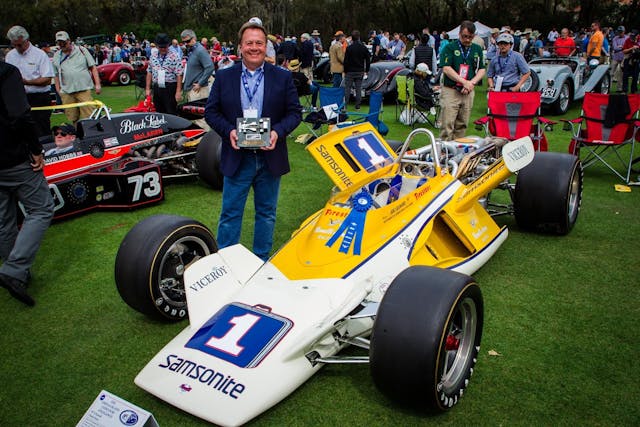
“At the end of the day, even though this car didn’t start off with such a promising set of attributes, by end of season it was the IndyCar champion. Part of the obligation I feel is not only to share the car with public at as many events as I can, but to make sure that the story of Joe Leonard and Johnny Capels and their tenacity and ingenuity doesn’t get lost.”
As it sits today, the Samsonite-sponsored #102 also boasts the inboard rear brakes and the rising rate suspension unique to its Mark 1 configuration.
Standing beside chassis #102 at American Speed Festival 2021, wearings jeans, Puma sneakers, and a zip-up IMS jacket, Chuck can’t talk about driving the car without grinning.
“It’s a hoot. It’s like a light switch—either on or off. It’s just 1970s tech.” Perhaps surprisingly, the VPJ-1 isn’t especially temperamental, and it’s proved “amazingly reliable.” Jones runs it between five and six times a year and has yet to suffer a major mechanical issue.
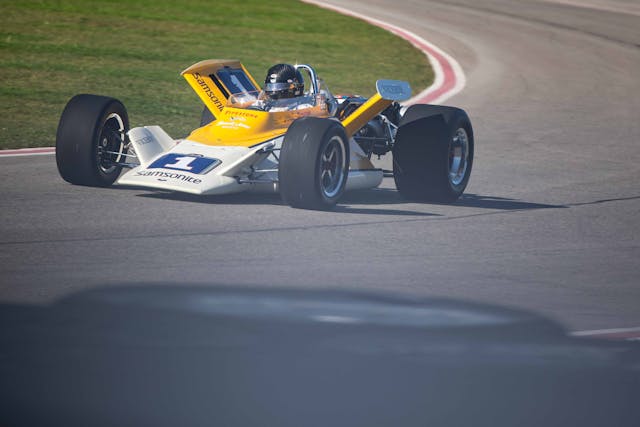
Here at M1 Concourse for the Speed Festival, the VPJ-1 doesn’t have much chance to stretch its legs, but exercise for the car only part of why Chuck has made the trip to Pontiac from western Michigan. “I’m hopeful that just like I was so captivated going to these early races with my father and his friend, that somehow it will light a spark and really connect with future generations.
“These cars deserve to be restored, they deserve to be shared with the public in their natural environment, which is on a track making noise and going fast, and they deserve to continue to tell the story of innovation, of technology breakthroughs, of perseverance.”
At M1, on a sunny late-summer day, the VPJ-1 belongs to an eclectic yet illustrious paddock. Most conspicuous is the comically high wings of the iconic Chaparral 2E racer, kept company by no less than three other “2” cars. Surrounding a modern-day Grand Prix stocker, the original Hudson Hornet, and a painstaking replica of the first (and last) car Henry Ford raced is a veritable flock of open-wheel cars. The good humor and camaraderie within the tents is palpable and in no small part due to the tight-knit group of vintage Ind car owners, like Chuck. Just down the line from the VPJ-1 is a Domino-liveried Lola T8600 driven in-period by Al Unser, Jr. So too is another ’72 racer—an Eagle arrayed in Sunoco blue and yellow, originally built by Mark Donohue and Penske crew chief Karl Kainhofer on the team’s shop floor in Pennsylvania in just four weeks. Each owner, it’s clear, carries the same custodial spirit as Chuck does towards his VPJ-1. Folding chairs creak quietly as the men lean back. The stories flow.

Certainly the racing teams of yesteryear had no inkling of the significance that a wrecked tub might one day represent, decades later, to someone like Chuck Jones. The mechanics probably couldn’t imagine someone rescuing a chassis, even a race- and championship-winning thing, much less spending four years and thousands of dollars bringing it back to life. As any enthusiast will tell you, though, the power of a car’s story extends beyond the physical metal and rubber that comprise it. That’s what Chuck latched onto. The reborn Samsonite VPJ-1 is in one sense a failure. At the same time, it’s a reminder of the hard work and ever-evolving effort that leads to victory. History now has the opportunity to remember it more as the latter.
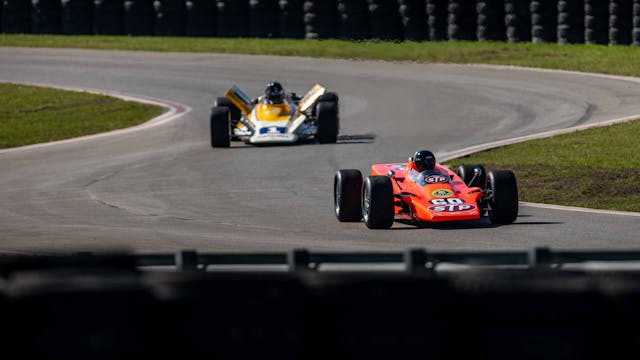
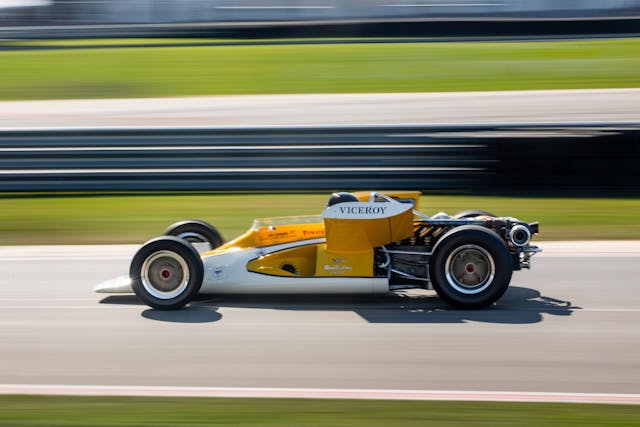
















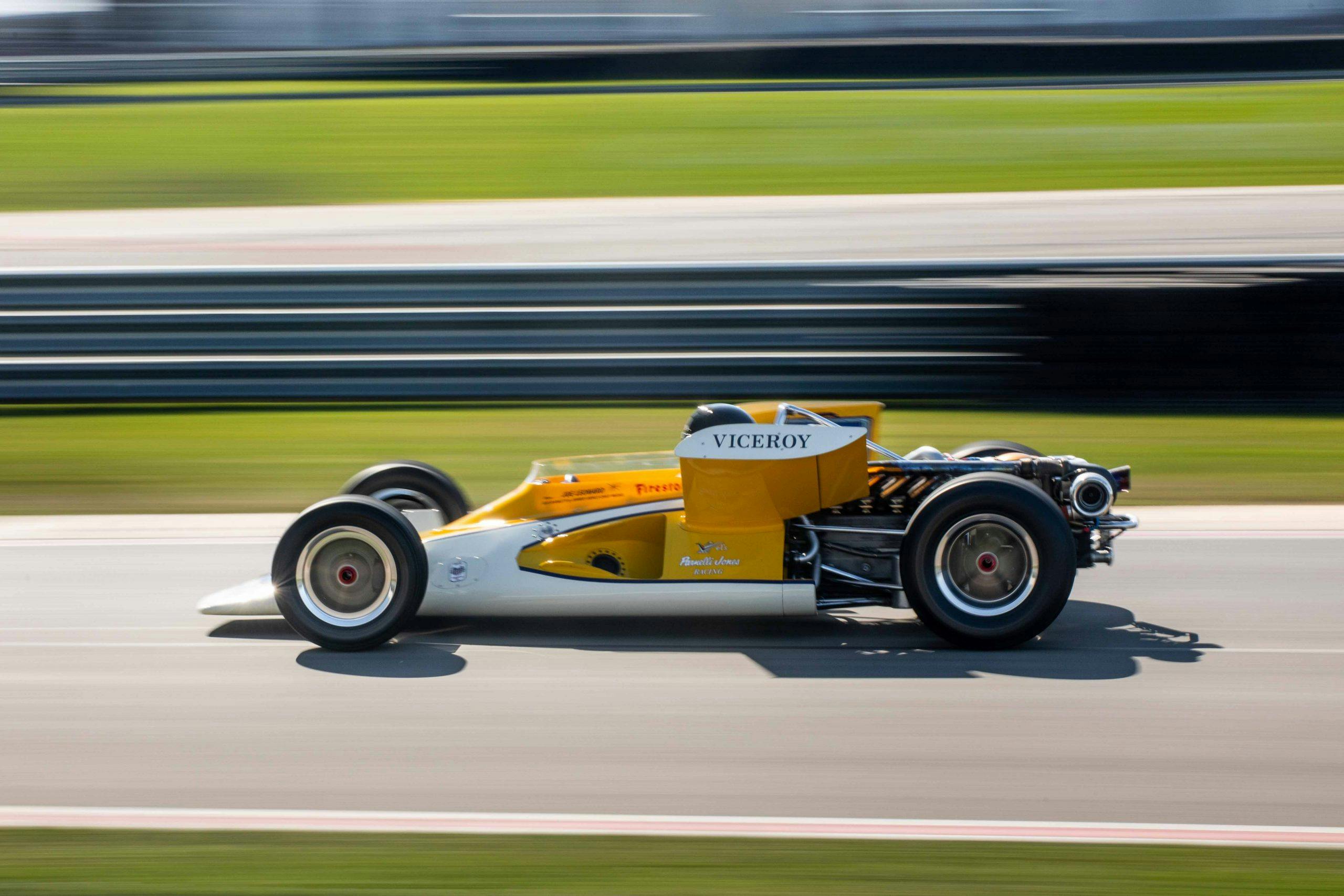
Those aren’t “upswept canards” inboard of the front wheels. They’re structural elements that provide pickup points for the upper A-arms, made necessary by the front portion of the monocoque being much lower than any of the VPJ-1’s competitors.